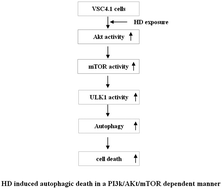2,5-Hexanedione induces autophagic death of VSC4.1 cells via a PI3K/Akt/mTOR pathway
Abstract
2,5-Hexanedione (HD) is an important bioactive metabolite of n-hexane, which mediates the neurotoxicity of the parent compound. Increasing evidence suggests that over-activated autophagy can lead to autophagic neuronal death; however, whether the excessive autophagy is involved in HD-induced neurotoxicity remains unknown. To investigate the effect of HD on autophagy and to find its underlying mechanism, we respectively treated VSC4.1 cells with 5, 15 and 25 mM HD for 24 h. Our results show that HD induced excessive autophagy of VSC4.1 cells in a dose-dependent manner, also, the over-activated autophagy was significantly mitigated in the presence of PI3K activator or Akt activator or mTOR activator. These results indicate that HD induces excessive autophagy of VSC4.1 cells by repressing the PI3K/Akt/mTOR signaling pathway. LDH assay showed that HD contributed to a concentration dependent increase in VSC4.1 cell death, which was significantly reduced by the administration of PIK-III, an autophagy inhibitor. These results also indicate that HD induces autophagic death of VSC4.1 cells via the signaling pathway.



 Please wait while we load your content...
Please wait while we load your content...